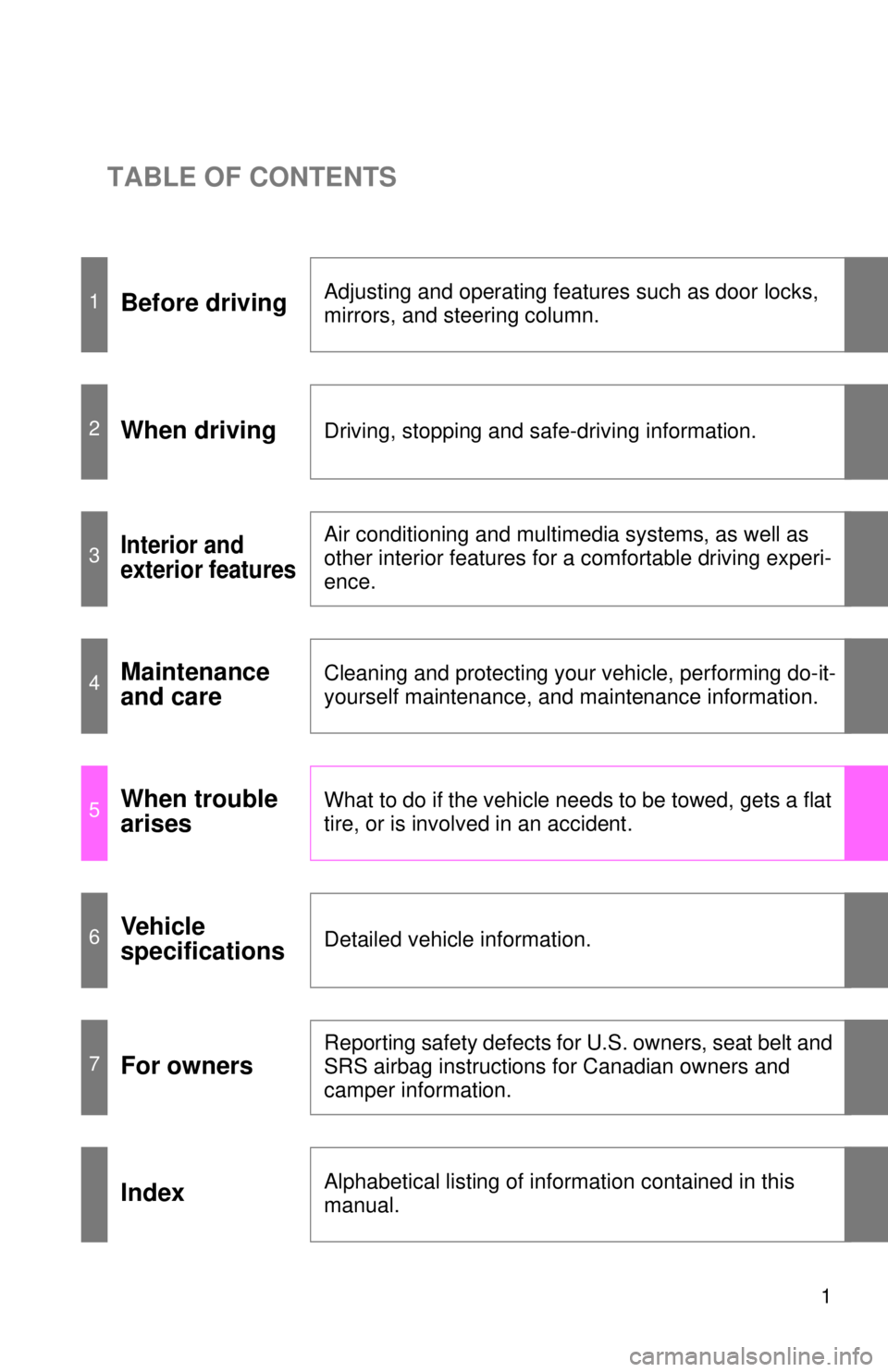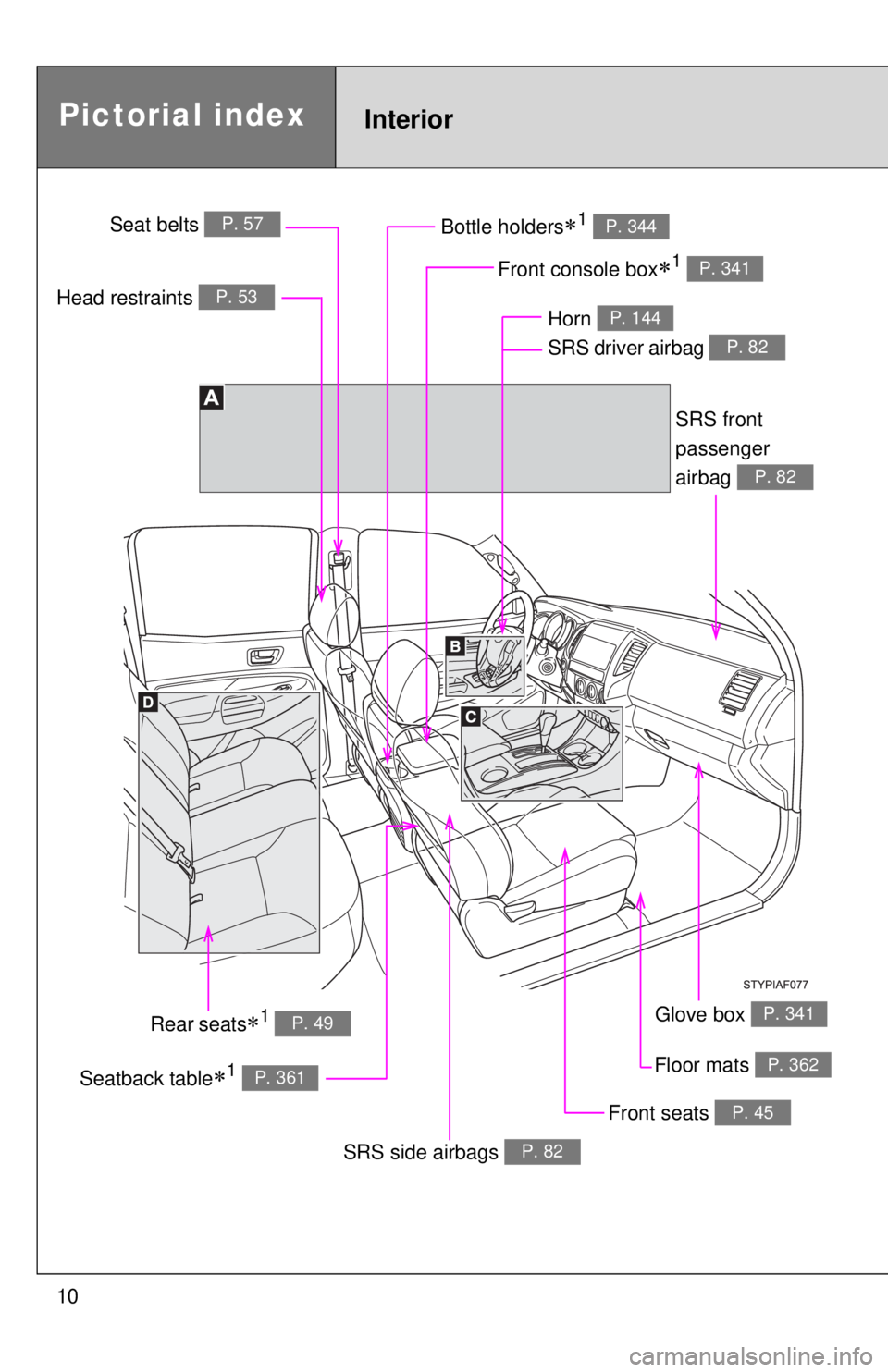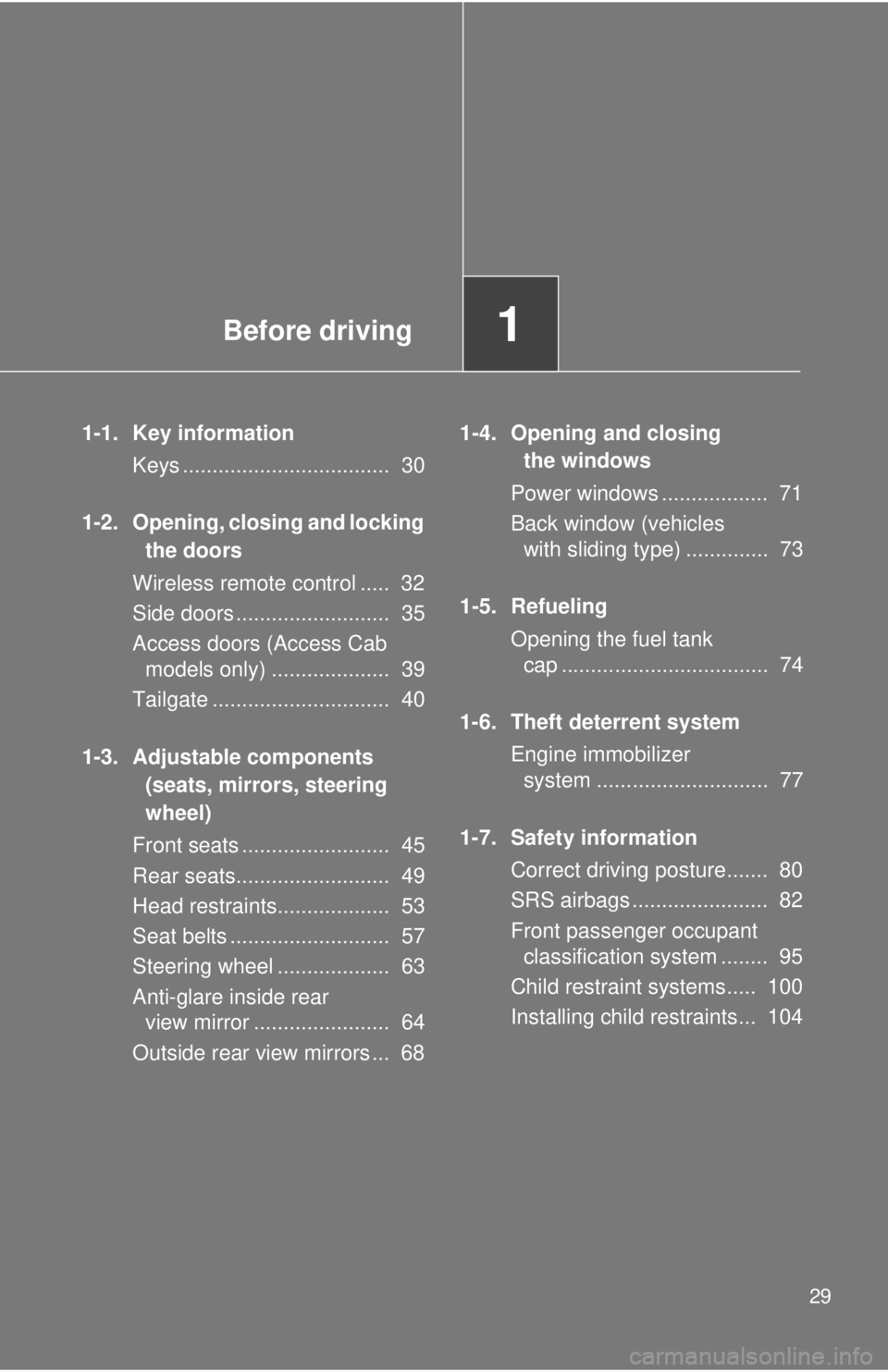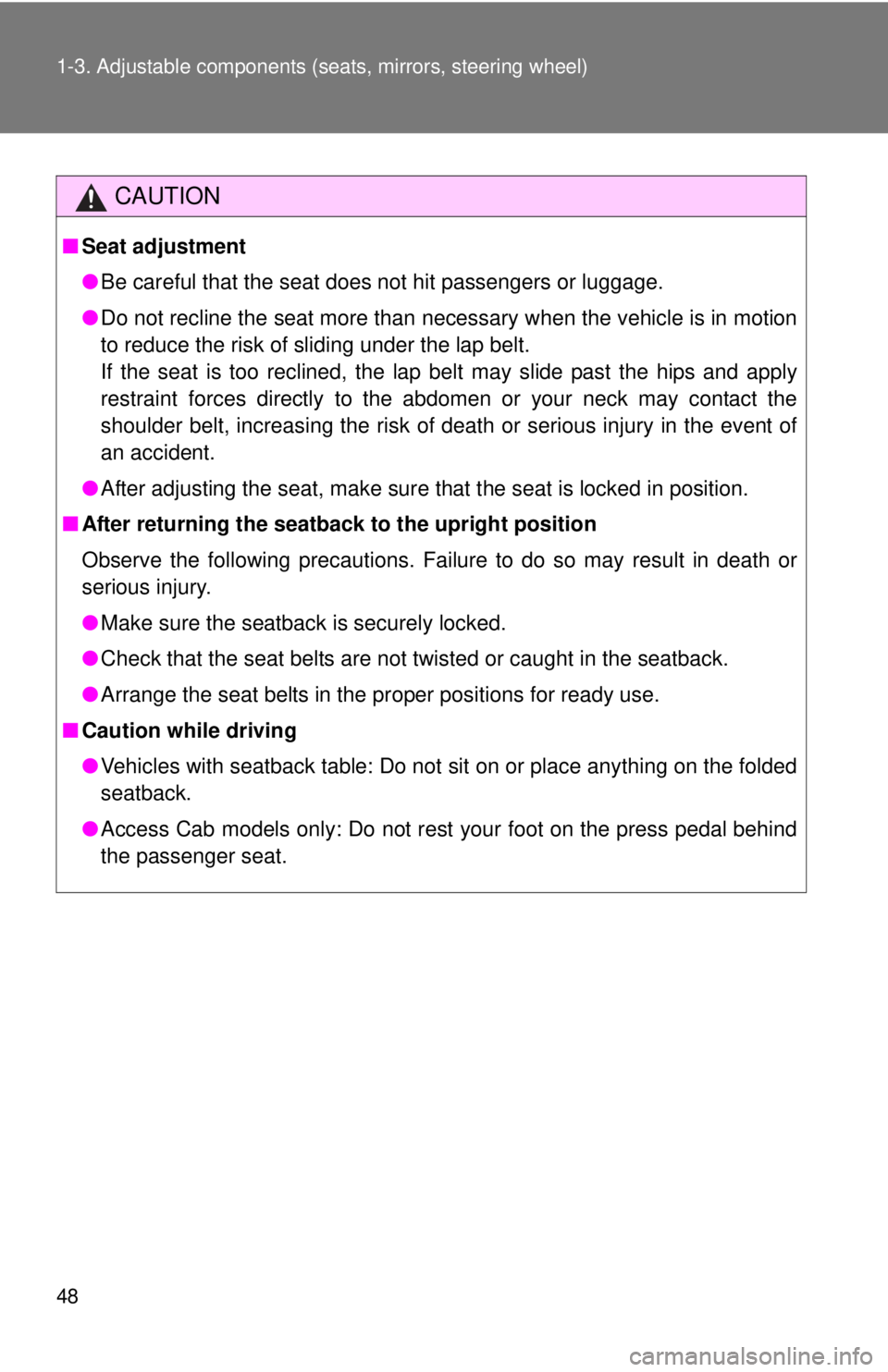belt TOYOTA TACOMA 2015 Owners Manual (in English)
[x] Cancel search | Manufacturer: TOYOTA, Model Year: 2015, Model line: TACOMA, Model: TOYOTA TACOMA 2015Pages: 590, PDF Size: 10.75 MB
Page 1 of 590

TABLE OF CONTENTS
1
1Before drivingAdjusting and operating features such as door locks,
mirrors, and steering column.
2When drivingDriving, stopping and safe-driving information.
3Interior and
exterior featuresAir conditioning and multimedia systems, as well as
other interior features for a comfortable driving experi-
ence.
4Maintenance
and careCleaning and protecting your vehicle, performing do-it-
yourself maintenance, and maintenance information.
5When trouble
arisesWhat to do if the vehicle needs to be towed, gets a flat
tire, or is involved in an accident.
6Vehicle
specificationsDetailed vehicle information.
7For owners
Reporting safety defects for U.S. owners, seat belt and
SRS airbag instructions for Canadian owners and
camper information.
IndexAlphabetical listing of information contained in this
manual.
Page 2 of 590

TABLE OF CONTENTSIndex
2
1-1. Key informationKeys ..................................... 30
1-2. Opening, closing and locking the doors
Wireless remote control ....... 32
Side doors ............................ 35
Access doors (Access Cab models only) ....................... 39
Tailgate ................................ 40
1-3. Adjustable components (seats, mirrors, steering
wheel)
Front seats ........................... 45
Rear seats ............................ 49
Head restraints ..................... 53
Seat belts ............................. 57
Steering wheel ..................... 63
Anti-glare inside rear view mirror .................................. 64
Outside rear view mirrors ..... 68
1-4. Opening and closing the windows
Power windows .................... 71
Back window (vehicles with sliding type) ........................ 73 1-5. Refueling
Opening the fuel tank cap..... 74
1-6. Theft deterrent system Engine immobilizer system ... 77
1-7. Safety information Correct driving posture ......... 80
SRS airbags ......................... 82
Front passenger occupant classification system ........... 95
Child restraint systems ....... 100
Installing child restraints ..... 104
2-1. Driving procedures Driving the vehicle .............. 120
Engine (ignition) switch....... 131
Automatic transmission ...... 134
Manual transmission........... 138
Turn signal lever ................. 141
Parking brake ..................... 142
Horn .................................... 144
2-2. Gauges and meters Gauges and meters ............ 145
Indicators and warning lights ................................. 148
1Before driving
2When driving
Page 5 of 590

1
2
3
4
5
6
7
5
5-1. Essential informationEmergency flashers ............ 466
If your vehicle needs to be towed ........................... 467
If you think something is wrong ................................ 474
Fuel pump shut off system .............................. 475
5-2. Steps to take in an emergency If a warning light turns on or a warning buzzer
sounds... ........................... 476
If you have a flat tire............ 486
If the engine will not start .... 501
If the shift lever cannot be shifted from P (vehicles
with an automatic
transmission) .................... 502
If you lose your keys ........... 503
If the vehicle battery is discharged ........................ 504
If your vehicle overheats ..... 508
If the vehicle becomes stuck ................................. 511
If your vehicle has to be stopped in
an emergency ................... 513 6-1. Specifications
Maintenance data (fuel, oil level, etc.) ........... 516
Fuel information.................. 537
Tire information .................. 540
6-2. Customization Customizable features........ 551
Items to initialize ................. 552
Reporting safety defects for U.S. owners ................ 554
Seat belt instructions for Canadian owners
(in French) ........................ 555
SRS airbag instructions for Canadian owners
(in French) ........................ 557
Camper information ............ 567
Abbreviation list ........................ 574
Alphabetical index .................... 576
What to do if... ........................... 585
5When trouble arises6Vehicle specifications
7For owners
Index
Page 10 of 590

10
Pictorial indexInterior
Seat belts P. 57
Head restraints P. 53
Bottle holders1 P. 344
Seatback table1 P. 361
SRS side airbags P. 82
Floor mats P. 362
SRS front
passenger
airbag
P. 82
Rear seats1 P. 49
Front seats P. 45
Glove box P. 341
Front console box1 P. 341
Horn
SRS driver airbag P. 144
P. 82
Page 23 of 590

23
Installation of a mobile two-way radio system
The installation of a mobile two-way radio system in your vehicle could affect
electronic systems such as:
●Multiport fuel injection system/sequential multiport fuel injection system
● Cruise control system
● Anti-lock brake system
● SRS airbag system
● Seat belt pretensioner system
Be sure to check with your Toyota dealer for precautionary measures or spe-
cial instructions regarding installation of a mobile two-way radio system.
Vehicle data recordings
Your Toyota is equipped with several sophisticated computers that will record
certain data, such as:
• Engine speed
• Accelerator status
• Brake status
• Vehicle speed
• Shift position (except manual transmission)
The recorded data varies according to the vehicle grade level and options
with which it is equipped. Furthermore, these computers do not record con-
versations, sounds or pictures.
● Data usage
Toyota may use the data recorded in these computers to diagnose malfunc-
tions, conduct research and development, and improve quality.
Toyota will not disclose the recorded data to a third party except:
• With the consent of the vehicle owner or with the consent of the lessee if the vehicle is leased
• In response to an official request by the police, a court of law or a govern-
ment agency
• For use by Toyota in a lawsuit
• For research purposes where the data is not tied to a specific vehicle or
vehicle owner
Page 24 of 590

24
Event data recorder
This vehicle is equipped with an event data recorder (EDR). The main pur-
pose of an EDR is to record, in certain crash or near crash-like situations,
such as an airbag deployment or hitting a road obstacle, data that will assist
in understanding how a vehicle’s systems performed. The EDR is designed
to record data related to vehicle dynamics and safety systems for a short
period of time, typically 30 seconds or less.
The EDR in this vehicle is designed to record such data as:
• How various systems in your vehicle were operating;
• Whether or not the driver and passenger safety belts were buckled/fas-tened;
• How far (if at all) the driver was depressing the accelerator and/or brake pedal; and,
• How fast the vehicle was traveling.
These data can help provide a better understanding of the circumstances in
which crashes and injuries occur.
NOTE: EDR data are recorded by your vehicle only if a non-trivial crash situ-
ation occurs; no data are recorded by the EDR under normal driving condi-
tions and no personal data (e.g., name, gender, age, and crash location) are
recorded. However, other parties, such as law enforcement, could combine
the EDR data with the type of personally identifying data routinely acquired
during a crash investigation.
To read data recorded by an EDR, special equipment is required, and access
to the vehicle or the EDR is needed. In addition to the vehicle manufacturer,
other parties, such as law enforcement, that have the special equipment, can
read the information if they have access to the vehicle or the EDR.
Page 25 of 590

25
●Disclosure of the EDR data
Toyota will not disclose the data recorded in an EDR to a third party except
when:
• An agreement from the vehicle’s owner (or the lessee for a leased vehicle) is obtained
• In response to an official request by the police, a court of law or a govern- ment agency
• For use by Toyota in a lawsuit
However, if necessary, Toyota may:
• Use the data for research on vehicle safety performance
• Disclose the data to a third party for research purposes without disclosing information about the specific vehicle or vehicle owner
Scrapping of your Toyota
The SRS airbag and seat belt pretensioner devices in your Toyota contain
explosive chemicals. If the vehicle is scrapped with the airbags and seat belt
pretensioners left as they are, this may cause an accident such as fire. Be
sure to have the systems of the SRS airbag and seat belt pretensioner
removed and disposed of by a qualified service shop or by your Toyota
dealer before you scrap your vehicle.
Perchlorate Material
Special handling may apply,
See www.dtsc.ca.gov/hazardouswaste/perchlorate.
Your vehicle has components that may contain perchlorate. These compo-
nents may include airbag, seat belt pretensioners, and wireless remote con-
trol batteries.
Page 29 of 590

Before driving1
29
1-1. Key informationKeys ................................... 30
1-2. Opening, closing and locking the doors
Wireless remote control ..... 32
Side doors .......................... 35
Access doors (Access Cab models only) .................... 39
Tailgate .............................. 40
1-3. Adjustable components (seats, mirrors, steering
wheel)
Front seats ......................... 45
Rear seats.......................... 49
Head restraints................... 53
Seat belts ........................... 57
Steering wheel ................... 63
Anti-glare inside rear view mirror ....................... 64
Outside rear view mirrors ... 68 1-4. Opening and closing
the windows
Power windows .................. 71
Back window (vehicles with sliding type) .............. 73
1-5. Refueling Opening the fuel tank cap ................................... 74
1-6. Theft deterrent system Engine immobilizer system ............................. 77
1-7. Safety information Correct driving posture....... 80
SRS airbags ....................... 82
Front passenger occupant classification system ........ 95
Child restraint systems..... 100
Installing child restraints... 104
Page 38 of 590

38 1-2. Opening, closing and locking the doors
CAUTION
■To prevent an accident
Observe the following precautions while driving the vehicle.
Failing to do so may result in a door opening and an occupant falling out,
resulting in death or serious injury.
●Always use a seat belt.
● Always lock all doors.
● Ensure that all doors are properly closed.
● Do not pull the inside handle of the doors while driving.
The doors may be opened and the passengers are thrown out of the vehi-
cle and it may result in serious injury or death.
Be especially careful for the front doors, as the doors may be opened even
if the inside lock buttons are in locked position.
● Set the rear door child protector locks when children are seated in the rear
seat.
Page 48 of 590

48 1-3. Adjustable components (seats, mirrors, steering wheel)
CAUTION
■Seat adjustment
●Be careful that the seat does not hit passengers or luggage.
● Do not recline the seat more than necessary when the vehicle is in motion
to reduce the risk of sliding under the lap belt.
If the seat is too reclined, the lap belt may slide past the hips and apply
restraint forces directly to the abdomen or your neck may contact the
shoulder belt, increasing the risk of death or serious injury in the event of
an accident.
● After adjusting the seat, make sure that the seat is locked in position.
■ After returning the seatback to the upright position
Observe the following precautions. Failure to do so may result in death or
serious injury.
● Make sure the seatback is securely locked.
● Check that the seat belts are not twisted or caught in the seatback.
● Arrange the seat belts in the proper positions for ready use.
■ Caution while driving
●Vehicles with seatback table: Do not sit on or place anything on the folded
seatback.
● Access Cab models only: Do not rest your foot on the press pedal behind
the passenger seat.